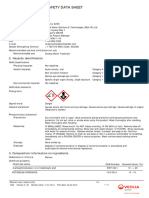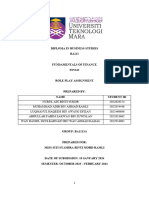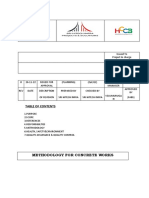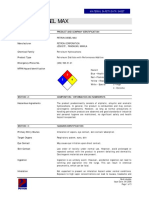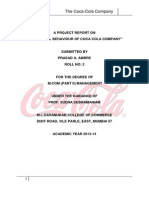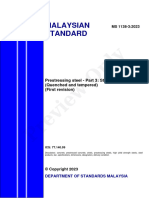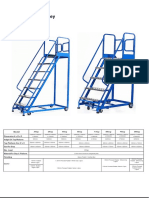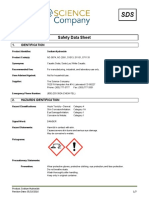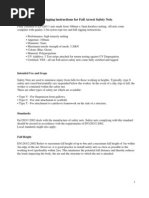SDS - Sodium Hypochlorite - Veolia
SDS - Sodium Hypochlorite - Veolia
Uploaded by
ShahrilCopyright:
Available Formats
SDS - Sodium Hypochlorite - Veolia
SDS - Sodium Hypochlorite - Veolia
Uploaded by
ShahrilOriginal Description:
Copyright
Available Formats
Share this document
Did you find this document useful?
Is this content inappropriate?
Copyright:
Available Formats
SDS - Sodium Hypochlorite - Veolia
SDS - Sodium Hypochlorite - Veolia
Uploaded by
ShahrilCopyright:
Available Formats
Version : 1.
0
Date of preparation : 14 January 2019
SAFETY DATA SHEET
SODIUM HYPOCHLORITE
Section 1: Identification of the chemical and of the supplier
Product identifier SODIUM HYPOCHLORITE
Other means of identification None.
Recommended use of the chemical and restrictions on use
Recommended use Not available.
Recommended restrictions None known.
Company/undertaking identification
Local Supplier's Name & Address :
SUEZ Water Technologies & Solutions Malaysia Sdn. Bhd.
(331480-D)
(formerly known as GE Water & Process Technologies
(Malaysia) Sdn. Bhd.)
Unit 20-08 & 20-09, Level 20, Q Sentral
2A, Jalan Stesen Sentral 2
Kuala Lumpur Sentral
50470 Kuala Lumpur
Tel: +603-27212615
Fax: +603-27212614
Emergency telephone
1-800-815-308 (Malaysia)
+1 703-527-3887 (US)
Section 2: Hazard identification
Physical hazards Corrosive to metals Category 1
Health hazards Acute toxicity (dermal) Category 4
Skin corrosion or irritation Category 1
Serious eye damage or eye irritation Category 1
Specific target organ toxicity - single Category 2
exposure
Environmental hazards Hazardous to the aquatic environment - Category 2
chronic hazard
Label elements
Signal word Danger
Hazard statement May be corrosive to metals. Harmful if in contact with skin. Causes severe skin burns and eye
damage. Causes serious eye damage. May cause damage to organs. Toxic to aquatic life with
long lasting effects.
Precautionary statement
Prevention Keep only in original container. Do not breathe mist or vapor. Wash thoroughly after handling.
Avoid release to the environment. Wear eye protection/face protection. Wear protective
gloves/protective clothing.
Product: SODIUM HYPOCHLORITE - Page 1 of 8
Version : 1.0
Date of preparation : 14 January 2019
SAFETY DATA SHEET
SODIUM HYPOCHLORITE
Response IF SWALLOWED: Rinse mouth. Do NOT induce vomiting. IF ON SKIN: Wash with plenty of soap
and water. IF ON SKIN (or hair): Remove/take off immediately all contaminated clothing. Rinse
skin with water/shower. IF INHALED: Remove victim to fresh air and keep at rest in a position
comfortable for breathing. IF IN EYES: Rinse cautiously with water for several minutes. Remove
contact lenses, if present and easy to do. Continue rinsing. Immediately call a POISON CENTER
or doctor/physician. Specific measures (see on this label). Wash contaminated clothing before
reuse. Absorb spillage to prevent material damage.
Storage Store locked up. Store in corrosive resistant/ container with a resistant inner liner.
Disposal Dispose of contents/container to .
Other hazards which do not None known.
result in classification
Supplemental information None.
Section 3: Composition and information of the ingredients of the hazardous chemical
Mixtures
Chemical name Common name and synonyms CAS number %
Sodium hypochlorite 7681-52-9 10 - 30
Sodium hydroxide 1310-73-2 <= 10
Section 4: First-aid measures
Inhalation Move to fresh air. Call a physician if symptoms develop or persist.
Skin contact Take off immediately all contaminated clothing. Rinse skin with water/shower. Call a physician or
poison control center immediately. Chemical burns must be treated by a physician. Wash
contaminated clothing before reuse.
Eye contact Immediately flush eyes with plenty of water for at least 15 minutes. Remove contact lenses, if
present and easy to do. Continue rinsing. Call a physician or poison control center immediately.
Ingestion Call a physician or poison control center immediately. Rinse mouth. Do not induce vomiting. If
vomiting occurs, keep head low so that stomach content doesn't get into the lungs.
Most important Burning pain and severe corrosive skin damage. Causes serious eye damage. Symptoms may
symptoms/effects, acute and include stinging, tearing, redness, swelling, and blurred vision. Permanent eye damage including
delayed blindness could result.
Indication of immediate Provide general supportive measures and treat symptomatically. Chemical burns: Flush with water
medical attention and special immediately. While flushing, remove clothes which do not adhere to affected area. Call an
treatment needed ambulance. Continue flushing during transport to hospital. Keep victim warm. Keep victim under
observation. Symptoms may be delayed.
General information If you feel unwell, seek medical advice (show the label where possible). Ensure that medical
personnel are aware of the material(s) involved, and take precautions to protect themselves. Show
this safety data sheet to the doctor in attendance.
Section 5: Fire-fighting measures
Suitable extinguishing media Foam. Powder. Carbon dioxide (CO2).
Unsuitable extinguishing Do not use water jet as an extinguisher, as this will spread the fire.
media
Specific hazards arising from During fire, gases hazardous to health may be formed.
the chemical
Special protective equipment Self-contained breathing apparatus and full protective clothing must be worn in case of fire.
and precautions for firefighters
Fire fighting Move containers from fire area if you can do so without risk.
equipment/instructions
HAZCHEM code None.
Specific methods Use standard firefighting procedures and consider the hazards of other involved materials.
Product: SODIUM HYPOCHLORITE - Page 2 of 8
Version : 1.0
Date of preparation : 14 January 2019
SAFETY DATA SHEET
SODIUM HYPOCHLORITE
Section 6: Accidental release measures
Personal precautions, Keep unnecessary personnel away. Keep people away from and upwind of spill/leak. Wear
protective equipment and appropriate protective equipment and clothing during clean-up. Do not breathe mist or vapor. Do
emergency procedures not touch damaged containers or spilled material unless wearing appropriate protective clothing.
Ensure adequate ventilation. Local authorities should be advised if significant spillages cannot be
contained. For personal protection, see section 8 of the SDS.
Environmental precautions Avoid release to the environment. Inform appropriate managerial or supervisory personnel of all
environmental releases. Prevent further leakage or spillage if safe to do so. Avoid discharge into
drains, water courses or onto the ground.
Methods and materials for Use water spray to reduce vapors or divert vapor cloud drift. Prevent entry into waterways, sewer,
containment and cleaning up basements or confined areas.
Large Spills: Stop the flow of material, if this is without risk. Dike the spilled material, where this is
possible. Absorb spillage to prevent material damage. Use a non-combustible material like
vermiculite, sand or earth to soak up the product and place into a container for later disposal.
Following product recovery, flush area with water.
Small Spills: Wipe up with absorbent material (e.g. cloth, fleece). Clean surface thoroughly to
remove residual contamination.
Never return spills to original containers for re-use. For waste disposal, see section 13 of the SDS.
Section 7: Handling and storage
Precautions for safe handling Do not get in eyes, on skin, or on clothing. Avoid prolonged exposure. When using, do not eat,
drink or smoke. Provide adequate ventilation. Wear appropriate personal protective equipment.
Wash hands thoroughly after handling. Avoid release to the environment. Wash contaminated
clothing before reuse. Observe good industrial hygiene practices.
Conditions for safe storage, Store locked up. Store in a cool, dry place out of direct sunlight. Store in corrosive resistant
including any incompatibilities container with a resistant inner liner. Store in tightly closed container. Keep only in the original
container. Store away from incompatible materials (see Section 10 of the SDS).
Section 8: Exposure controls and personal protection
Occupational exposure limits
Malaysia. OELs. (Occupational Safety and Health (Use and Standards of Exposure of Chemicals Hazardous to Health)
Regulations)
Components Type Value
Sodium hydroxide (CAS Ceiling 2 mg/m3
1310-73-2)
US. ACGIH Threshold Limit Values
Components Type Value
Sodium hydroxide (CAS Ceiling 2 mg/m3
1310-73-2)
Biological limit values No biological exposure limits noted for the ingredient(s).
Appropriate engineering Good general ventilation (typically 10 air changes per hour) should be used. Ventilation rates
controls should be matched to conditions. If applicable, use process enclosures, local exhaust ventilation,
or other engineering controls to maintain airborne levels below recommended exposure limits. If
exposure limits have not been established, maintain airborne levels to an acceptable level. Eye
wash facilities and emergency shower must be available when handling this product.
Individual protection measures, such as personal protective equipment
Eye/face protection Wear safety glasses with side shields (or goggles) and a face shield.
Skin protection
Hand protection Wear appropriate chemical resistant gloves.
Other Wear appropriate chemical resistant clothing. Use of an impervious apron is recommended.
Respiratory protection Chemical respirator with organic vapor cartridge and full facepiece.
Thermal hazards Wear appropriate thermal protective clothing, when necessary.
General hygiene Always observe good personal hygiene measures, such as washing after handling the material
considerations and before eating, drinking, and/or smoking. Routinely wash work clothing and protective
equipment to remove contaminants.
Product: SODIUM HYPOCHLORITE - Page 3 of 8
Version : 1.0
Date of preparation : 14 January 2019
SAFETY DATA SHEET
SODIUM HYPOCHLORITE
Section 9: Physical and chemical properties
Appearance Liquid
Physical state Liquid.
Form Liquid.
Color Light yellow to green
Odor Chlorine
Odor threshold Not available.
pH (concentrated product) 13.2
pH in aqueous solution 11.5 (5% SOL.)
Melting point/freezing point -26 °C
Initial boiling point and boiling Not available.
range
Flash point > 93 °C P-M(CC)
Evaporation rate < 1 (Ether = 1)
Flammability (solid, gas) Not applicable.
Upper/lower flammability or explosive limits
Flammability limit - lower Not available.
(%)
Flammability limit - upper Not available.
(%)
Explosive limit - lower (%) Not available.
Explosive limit - upper (%) Not available.
Vapor pressure 18 mm Hg
Vapor pressure temp. 21 °C
Vapor density 1 (Air = 1)
Relative density 1.22
Relative density temperature 21 °C
Solubility(ies)
Solubility (water) 100 %
Partition coefficient Not available.
(n-octanol/water)
Auto-ignition temperature Not available.
Decomposition temperature Not available.
Viscosity 13 cps
Viscosity temperature 21 °C
Other information
Explosive properties Not explosive.
Oxidizing properties Not oxidizing.
Pour point -23 °C
Specific gravity 1.219
VOC 0 % (Estimated)
Section 10: Stability and reactivity
Reactivity May be corrosive to metals.
Chemical stability Material is stable under normal conditions.
Possibility of hazardous Hazardous polymerization does not occur.
reactions
Conditions to avoid Keep away from heat, hot surfaces, sparks, open flames and other ignition sources. Avoid
temperatures exceeding the flash point. Contact with incompatible materials.
Product: SODIUM HYPOCHLORITE - Page 4 of 8
Version : 1.0
Date of preparation : 14 January 2019
SAFETY DATA SHEET
SODIUM HYPOCHLORITE
Incompatible materials Strong acids. Strong oxidizing agents. Metals.
Hazardous decomposition No hazardous decomposition products are known.
products
Section 11: Toxicological information
Information on likely routes of exposure
Inhalation May cause damage to organs by inhalation. May cause irritation to the respiratory system.
Prolonged inhalation may be harmful.
Skin contact Causes severe skin burns. Harmful in contact with skin.
Eye contact Causes serious eye damage.
Ingestion Causes digestive tract burns.
Symptoms related to the Burning pain and severe corrosive skin damage. Causes serious eye damage. Symptoms may
physical, chemical and include stinging, tearing, redness, swelling, and blurred vision. Permanent eye damage including
toxicological characteristics blindness could result.
Information on toxicological effects
Acute toxicity Harmful in contact with skin.
Product Species Test Results
SODIUM HYPOCHLORITE (CAS Mixture)
Acute
Dermal
LD50 Rabbit 3000 mg/kg
Inhalation
LC50 Rat > 10.5 mg/L, 1 Hour, (Value is for 12.5%
active.)
Oral
LD50 Rat > 5000 mg/kg
Components Species Test Results
Sodium hydroxide (CAS 1310-73-2)
Acute
Dermal
LD50 Rabbit 1350 mg/kg
Oral
LD50 Rabbit > 500 mg/kg
Sodium hypochlorite (CAS 7681-52-9)
Acute
Dermal
LD50 Rabbit > 20000 mg/kg
Inhalation
LC50 Rat > 5.25 mg/L, 4 Hour
Oral
LD50 Rat 8900 mg/kg
Skin corrosion/irritation Prolonged skin contact may cause temporary irritation.
Serious eye damage/eye Causes serious eye damage.
irritation
Respiratory or skin sensitization
Respiratory sensitization Not a respiratory sensitizer. This product is not expected to cause respiratory sensitization.
Skin sensitization This product is not expected to cause skin sensitization.
Germ cell mutagenicity No data available to indicate product or any components present at greater than 0.1% are
mutagenic or genotoxic.
Carcinogenicity
Product: SODIUM HYPOCHLORITE - Page 5 of 8
Version : 1.0
Date of preparation : 14 January 2019
SAFETY DATA SHEET
SODIUM HYPOCHLORITE
IARC Monographs. Overall Evaluation of Carcinogenicity
Sodium hypochlorite (CAS 7681-52-9) 3 Not classifiable as to carcinogenicity to humans.
Reproductive toxicity This product is not expected to cause reproductive or developmental effects.
Specific target organ toxicity - May cause damage to organs.
single exposure
Specific target organ toxicity - Not classified.
repeated exposure
Aspiration hazard Not an aspiration hazard.
Chronic effects Prolonged inhalation may be harmful.
Section 12: Ecological information
Ecotoxicity Toxic to aquatic life with long lasting effects.
Product Species Test Results
SODIUM HYPOCHLORITE (CAS Mixture)
LC50 Bluegill Sunfish 5.3 mg/L, Static Acute Bioassay, 96 hour
NOEL Bluegill Sunfish 2.8 mg/L, Static Acute Bioassay, 96 hour
Aquatic
Crustacea LC50 Daphnia magna 1.6 mg/L, Static Acute Bioassay, 48 hour
NOEL Daphnia magna 0.51 mg/L, Static Acute Bioassay, 48
hour
Fish LC50 Rainbow Trout 1.9 mg/L, Static Acute Bioassay, 96 hour
NOEL Rainbow Trout 1.38 mg/L, Static Acute Bioassay, 96
hour
Persistence and degradability Product contains only inorganics that are not subject to typical biological degradation. Assimilation
by microbes may occur in waste treatment or the environment. This product, being inorganic, has
no TOC, BOD.
Bioaccumulative potential No data available.
Mobility in soil No data available.
Other adverse effects No other adverse environmental effects (e.g. ozone depletion, photochemical ozone creation
potential, endocrine disruption, global warming potential) are expected from this component.
Environmental fate Toxic to aquatic life with long lasting effects.
Persistence and degradability
Product contains only inorganics that are not subject to typical biological degradation. Assimilation
by microbes may occur in waste treatment or the environment. This product, being inorganic, has
no TOC, BOD.
- COD (mgO2/g) No information available.
Section 13: Disposal information
Disposal instructions Collect and reclaim or dispose in sealed containers at licensed waste disposal site. Do not allow
this material to drain into sewers/water supplies. Do not contaminate ponds, waterways or ditches
with chemical or used container. Dispose of contents/container in accordance with
local/regional/national/international regulations.
Local disposal regulations Dispose in accordance with all applicable regulations.
Waste from residues / unused Dispose of in accordance with local regulations. Empty containers or liners may retain some
products product residues. This material and its container must be disposed of in a safe manner (see:
Disposal instructions).
Contaminated packaging Since emptied containers may retain product residue, follow label warnings even after container is
emptied. Empty containers should be taken to an approved waste handling site for recycling or
disposal.
Section 14: Transportation information
IATA
Basic shipping requirements:
UN number UN1791
Product: SODIUM HYPOCHLORITE - Page 6 of 8
Version : 1.0
Date of preparation : 14 January 2019
SAFETY DATA SHEET
SODIUM HYPOCHLORITE
Proper shipping name HYPOCHLORITE SOLUTIONS
Hazard class 8
Packing group II
Special transport Read safety instructions, SDS and emergency procedures before handling.
precautions and conditions
IMDG
Basic shipping requirements:
UN number UN1791
Proper shipping name HYPOCHLORITE SOLUTIONS
Hazard class 8
Packing group II
Marine pollutant No
Special transport Read safety instructions, SDS and emergency procedures before handling.
precautions and conditions
SEA (Annex II of MARPOL 73/78 Not established.
and the IBC Code)
IATA; IMDG
HAZCHEM code None.
Section 15: Regulatory information
Safety, health and environmental regulations specific for the product in question
Active Ingredients of Pesticide Product (Pesticide Act 1974, First Schedule, as amended through October 1, 2004)
Not regulated.
CWC (Chemical Weapons Convention) Act 2005, Schedules 1-3, as amended through CWC Regulations 2007, October 5,
2007)
Not regulated.
Medical Surveillance Chemicals, Occupational Safety and Health (Use and Standards of Exposure of Chemicals
Hazardous to Health) Regulations 2000: Schedule 2
Sodium hydroxide (CAS 1310-73-2)
Sodium hypochlorite (CAS 7681-52-9)
Ozone Depleting Substances (ODS) (Environmental Quality (Prohibition on the Use of CFC and Other Gases as
Propellants and Blowing Agents) Order 1993, Dec. 31, 1993)
Not regulated.
Poisons List (Poisons Act 1952, First Schedule)
Sodium hydroxide (CAS 1310-73-2) C
II
Prohibited Use of Substances [Occupational Safety and Health (Prohibition of Use of Substance) Order 1999]
Not regulated.
International regulations
Stockholm Convention
Not applicable.
Rotterdam Convention
Not applicable.
Montreal Protocol
Not applicable.
Product: SODIUM HYPOCHLORITE - Page 7 of 8
Version : 1.0
Date of preparation : 14 January 2019
SAFETY DATA SHEET
SODIUM HYPOCHLORITE
Kyoto protocol
Not applicable.
Basel Convention
Not applicable.
Section 16: Other information
Issue date Jan-14-2019
Revision date 14/01/2019
Version # 1.0
List of abbreviations Not available.
References Not available.
Disclaimer The information provided in this Safety Data Sheet is correct to the best of our knowledge,
information and belief at the date of its publication. The information given is designed only as a
guidance for safe handling, use, processing, storage, transportation, disposal and release and is
not to be considered a warranty or quality specification. The information relates only to the specific
material designated and may not be valid for such material used in combination with any other
materials or in any process, unless specified in the text.
Revision information This document has undergone significant changes and should be reviewed in its entirety.
Product: SODIUM HYPOCHLORITE - Page 8 of 8
You might also like
- 30.MSDS Hydrex 2250 SG - GHSDocument6 pages30.MSDS Hydrex 2250 SG - GHSPrabath VlogsNo ratings yet
- Project Quality Plan Rev. 01Document101 pagesProject Quality Plan Rev. 01raj86% (7)
- Termites Syn SDSDocument6 pagesTermites Syn SDSafiq.npcNo ratings yet
- Fin242 Role Play AssignmentDocument23 pagesFin242 Role Play Assignment2022628154No ratings yet
- NH Telehandler LM1340 1343 1345 1443 1445 1743 SM PDFDocument502 pagesNH Telehandler LM1340 1343 1345 1443 1445 1743 SM PDFanzor100% (3)
- MS 2530 - 3 - 2013 - FullpdfDocument27 pagesMS 2530 - 3 - 2013 - Fullpdfnoor khairaniNo ratings yet
- Dam Safety Concepts ICOLDDocument38 pagesDam Safety Concepts ICOLDAdrielly Fonseca100% (1)
- 1-Soalan Assignment 1Document14 pages1-Soalan Assignment 1Ahmad KhuwarizmyNo ratings yet
- SDS Krystal KAP English Version 1.08.19Document8 pagesSDS Krystal KAP English Version 1.08.19Fikriey AbdullahNo ratings yet
- Safe Use of Lifting Equipment and Lifting AccessoriesDocument27 pagesSafe Use of Lifting Equipment and Lifting AccessoriesUlviyye Elesgerova100% (2)
- Deutz F2M 2011, F3M 2011, F4M 2011, BF3M 2011, BF4M 2011, BF3L 2011, BF4L 2011 F2L 2011, F3L 2011, F4L 2011 Operation ManualDocument84 pagesDeutz F2M 2011, F3M 2011, F4M 2011, BF3M 2011, BF4M 2011, BF3L 2011, BF4L 2011 F2L 2011, F3L 2011, F4L 2011 Operation Manualcristian yarascaNo ratings yet
- 2ss7 Characteristics Curves of SemiconductorDocument47 pages2ss7 Characteristics Curves of SemiconductorluayNo ratings yet
- DC Drive System For EscalatorDocument29 pagesDC Drive System For EscalatorMamta Mrjn100% (2)
- SDS Hydraulic Oil AW 68Document6 pagesSDS Hydraulic Oil AW 68aminNo ratings yet
- Method Statement For General Concrete WorksDocument6 pagesMethod Statement For General Concrete WorksGOKULACHANDRU SNo ratings yet
- Respiratory Paediatric Short Case PresentationDocument2 pagesRespiratory Paediatric Short Case PresentationWong Chun HsienNo ratings yet
- SDS - Dissolved - Acetylene - Linde - EngDocument10 pagesSDS - Dissolved - Acetylene - Linde - EngmegatNo ratings yet
- SDS - Oxygen - Compressed - Linde - EngDocument10 pagesSDS - Oxygen - Compressed - Linde - EngmegatNo ratings yet
- K 1 K 2 ManualDocument92 pagesK 1 K 2 ManualAnonymous Vi826aEesNo ratings yet
- School of Civil Engineering: (Assignment/Project Received Without This Declaration Form Will Not Be Graded)Document12 pagesSchool of Civil Engineering: (Assignment/Project Received Without This Declaration Form Will Not Be Graded)NasrulNo ratings yet
- Pad Footing.1Document43 pagesPad Footing.1Cliff Jude ZehnderNo ratings yet
- Chapter 1b - Environmental Rules & Regulations MalaysiaDocument33 pagesChapter 1b - Environmental Rules & Regulations Malaysiascribd1991100% (6)
- MSDS Petron Diesel MaxDocument5 pagesMSDS Petron Diesel MaxDomsNo ratings yet
- Fyp Technical Paper - Nurul Syafiqah Rosli - kh17033Document9 pagesFyp Technical Paper - Nurul Syafiqah Rosli - kh17033anis amiraNo ratings yet
- UntitledDocument302 pagesUntitledAsvin AngNo ratings yet
- JKKP 7Document1 pageJKKP 7SwanBellaNo ratings yet
- Organizational Structure of The Coca Cola CompanyDocument37 pagesOrganizational Structure of The Coca Cola Companyprasadmahajan26No ratings yet
- Report PV1 F3Document16 pagesReport PV1 F3iddin ismail0% (1)
- Revision For Mid Exam Beeb3023 Intmd Macro A191 1Document18 pagesRevision For Mid Exam Beeb3023 Intmd Macro A191 1Amirul AimanNo ratings yet
- MS 1138-3-2023Document5 pagesMS 1138-3-2023LAVOS100% (1)
- SW 306Document2 pagesSW 306muhammad.amir.sollehin.yusoff100% (1)
- Bahagian Kawalan Racun Perosak - Jabatan PertanianDocument228 pagesBahagian Kawalan Racun Perosak - Jabatan Pertanian李国振No ratings yet
- Volvo B230eDocument22 pagesVolvo B230eNahuel HernandezNo ratings yet
- Jabatan Kerja Raya: Manual On Traffic Control Devices Temporary Signs and Work Zones ControlDocument4 pagesJabatan Kerja Raya: Manual On Traffic Control Devices Temporary Signs and Work Zones ControlHatim ShamsudinNo ratings yet
- Full Report XeriaDocument11 pagesFull Report XeriaHamierul MohamadNo ratings yet
- Abate MSDSDocument10 pagesAbate MSDS缪忠琴No ratings yet
- Blue Ladder Trolley CW Spring Back Door On Top Foot Climbed Stopper System PDFDocument1 pageBlue Ladder Trolley CW Spring Back Door On Top Foot Climbed Stopper System PDFSuresh DNo ratings yet
- TEST (50 Marks) : Course CodeDocument3 pagesTEST (50 Marks) : Course CodeNur Aiman NorahimNo ratings yet
- Documentation WRAPPING MACHINEDocument280 pagesDocumentation WRAPPING MACHINEVelaNo ratings yet
- Moreover,: A 116-Page Report Was Released by The Penang State Commission of Inquiry (SCI) On The Worksite IncidentDocument4 pagesMoreover,: A 116-Page Report Was Released by The Penang State Commission of Inquiry (SCI) On The Worksite IncidentAsogan JagaNo ratings yet
- INTERZINC 22 Part B - SDSDocument7 pagesINTERZINC 22 Part B - SDSjorgekarlosprNo ratings yet
- Chemistry Chapter 8 Manufactured Substances in IndustryDocument24 pagesChemistry Chapter 8 Manufactured Substances in Industrym-9575525No ratings yet
- Construction Project Management (ECM 566) Group ProjectDocument40 pagesConstruction Project Management (ECM 566) Group Projectaimiranger1No ratings yet
- Component Design Report - Group 3-MergedDocument84 pagesComponent Design Report - Group 3-MergedAidil ZaineeNo ratings yet
- Sodium Hydroxide Solid SDSDocument7 pagesSodium Hydroxide Solid SDSAnya Putri RayhaniNo ratings yet
- Hoja de Seguridad Clinafarm - Spray - SDS - InglesDocument9 pagesHoja de Seguridad Clinafarm - Spray - SDS - Inglessst incubacolNo ratings yet
- MSDS Total NitrogenDocument10 pagesMSDS Total NitrogenTrung Trinh BaoNo ratings yet
- Phosphoric Acid MSDSDocument11 pagesPhosphoric Acid MSDSKeily VilcarromeroNo ratings yet
- Msds Nu BriteDocument8 pagesMsds Nu BriteJosé María Quintero Q.No ratings yet
- Chockfast Orange Hardener SDS Canada EU EnglishDocument7 pagesChockfast Orange Hardener SDS Canada EU EnglishfebriNo ratings yet
- Hydrochloric Acid 22 Baume 35 37 English 2017Document7 pagesHydrochloric Acid 22 Baume 35 37 English 2017Nitika SinhaNo ratings yet
- SDS-US_CAN-English-Iron-Out-Spray-Rust-Stain-Remover-2022Document8 pagesSDS-US_CAN-English-Iron-Out-Spray-Rust-Stain-Remover-2022mike garvinNo ratings yet
- SDS - Olin - KOH - 30 - US - SDS - US - EnglishDocument8 pagesSDS - Olin - KOH - 30 - US - SDS - US - EnglishLuis Carbajal CusiNo ratings yet
- Kodak Alaris SDS US English - Kodafix Solution 1058452Document8 pagesKodak Alaris SDS US English - Kodafix Solution 1058452Michelle SilberbergNo ratings yet
- E-Microban Additive ZO6 SDS TWDocument7 pagesE-Microban Additive ZO6 SDS TW呂仲書No ratings yet
- Safety Data Sheet: 1. IdentificationDocument7 pagesSafety Data Sheet: 1. Identificationyohnnier castroNo ratings yet
- GENGARD GN8203: Safety Data SheetDocument9 pagesGENGARD GN8203: Safety Data Sheettshahad312No ratings yet
- Safety Data Sheet: 1. IdentificationDocument10 pagesSafety Data Sheet: 1. Identificationnorfatin fadzlinda nordinNo ratings yet
- Hydrex 7943 IsoDocument8 pagesHydrex 7943 Isonw5kt744qbNo ratings yet
- MSDS Yeser® EDTA 2na Rev.Document8 pagesMSDS Yeser® EDTA 2na Rev.Adiba Naura ShakilaNo ratings yet
- Sulfuric Acid NitrateDocument10 pagesSulfuric Acid NitrateAliNo ratings yet
- Sds+Silco+Rtv+4500+ +clearDocument11 pagesSds+Silco+Rtv+4500+ +clearLeslie Escobar RobertoNo ratings yet
- SafetyDataSheet (SDS) AristonicAcidH EN 06302021Document9 pagesSafetyDataSheet (SDS) AristonicAcidH EN 06302021shelmakrmNo ratings yet
- CF Detergent Powder MSDSDocument11 pagesCF Detergent Powder MSDSAmriNo ratings yet
- Occupational Safety and Health Act: Laws of KenyaDocument79 pagesOccupational Safety and Health Act: Laws of Kenyamoses machiraNo ratings yet
- Kluber Kluberplex BEM 41-141 - enDocument7 pagesKluber Kluberplex BEM 41-141 - engabriela.bahamondes.pNo ratings yet
- SUN2000 - (55KTL, 60KTL) Series User ManualDocument121 pagesSUN2000 - (55KTL, 60KTL) Series User ManualDaniel CastroNo ratings yet
- Hot Work PT 1Document4 pagesHot Work PT 1Maria Camila AtehortuaNo ratings yet
- Naples Fire Chief Pete DiMaria Retirement Letter - 8-31-2021Document2 pagesNaples Fire Chief Pete DiMaria Retirement Letter - 8-31-2021Omar Rodriguez OrtizNo ratings yet
- Hardware Manual: Abb Drives For WaterDocument310 pagesHardware Manual: Abb Drives For WatermayurNo ratings yet
- Information Sheet: Crystalline Silica DustDocument2 pagesInformation Sheet: Crystalline Silica DustMohamad Hidayat Zainul MasriNo ratings yet
- Nfa Extinguisher GuidelinesDocument11 pagesNfa Extinguisher Guidelinesaseli tuicoloNo ratings yet
- Method Statement - Reclamation Works - C01 - Ver6Document47 pagesMethod Statement - Reclamation Works - C01 - Ver6Julian Sandoval100% (1)
- Hse PL 0001 - Hse Site Plan - Rev.2Document158 pagesHse PL 0001 - Hse Site Plan - Rev.2Zakaria MtepaNo ratings yet
- 9 CIC 2016 Post CompletionDocument3 pages9 CIC 2016 Post CompletionWandersonNo ratings yet
- PCS-915 Distributed Busbar Protection Instruction Manual en Overseas General X R1.01 (En YJBH5300.0086.0002)Document258 pagesPCS-915 Distributed Busbar Protection Instruction Manual en Overseas General X R1.01 (En YJBH5300.0086.0002)Proteksitrans1 p3bsNo ratings yet
- APV CU4 ASiDocument47 pagesAPV CU4 ASiLuiz Carlos TilhaNo ratings yet
- OISD GDN 182draftDocument60 pagesOISD GDN 182draftramptgdNo ratings yet
- OM - R36 - 001 - ENG - 09.06.2017 - CLW Rotor Operating Manual PDFDocument465 pagesOM - R36 - 001 - ENG - 09.06.2017 - CLW Rotor Operating Manual PDFashik111100750% (2)
- EIS Engineering Profile - DOWNLOADDocument22 pagesEIS Engineering Profile - DOWNLOADMechatronics EngineeringNo ratings yet
- Safety Moments For Chairs MeetingsDocument96 pagesSafety Moments For Chairs MeetingsImran KhanNo ratings yet
- Fall Prevention For ScaffoldersDocument9 pagesFall Prevention For ScaffoldersFirdosh AnsariNo ratings yet
- Final RISKDocument2 pagesFinal RISKRegina IldefonsoNo ratings yet
- HIRA No. 02-Use of Access Scaffolding SBDDocument2 pagesHIRA No. 02-Use of Access Scaffolding SBDVenkadesh Periathambi25% (4)
- Specification of Safety NetDocument5 pagesSpecification of Safety Netdeepak_023100% (1)
- Renewables 2012 06-05-07 QualityDocument30 pagesRenewables 2012 06-05-07 QualityRodrigo Andrade da SilveiraNo ratings yet
- Pha-Bls 2H2019Document3 pagesPha-Bls 2H2019Abram BunoanNo ratings yet
- 90ZV-2 Operators ManualDocument222 pages90ZV-2 Operators ManualKawasaki100% (1)
- X INS-3 - 2023 Offshore Inspection On Marine Outfall PipelineDocument5 pagesX INS-3 - 2023 Offshore Inspection On Marine Outfall PipelineAhmed ELmlahyNo ratings yet
- Emergency Stop, Configurable Stop Category 0 or 1 (Option +Q978) For ACS880-07/07LC/17/17LC/37/37LC DrivesDocument74 pagesEmergency Stop, Configurable Stop Category 0 or 1 (Option +Q978) For ACS880-07/07LC/17/17LC/37/37LC Drivesdave chaudhuryNo ratings yet
